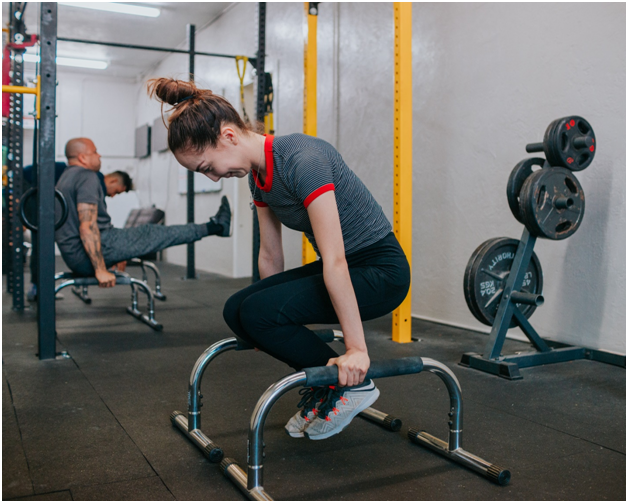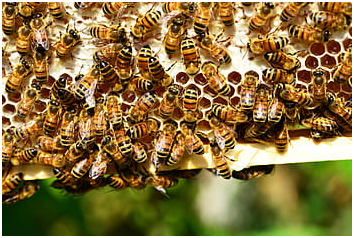
- Start with a wide base of support. Position feet at least hip width apart in a side by side or staggered stance. This maintains balance and reduces workload on the spine.
- Get as close to the object being lifted as possible, to avoid excessive forces through the spine.
- When bending to reach lower-level objects, maintain your spine in a neutral position with ears, shoulders and pelvis aligned, as you hinge at the hips and reach back with your buttocks while at the bending knees. Your knees should not pass in front of your toes as you are lifting, and like your feet, your knees should also be maintained at least hip width apart by engaging the muscles in your buttocks.
- Engage your abdominal core muscles as you prepare for and complete the lift.
- Know the limits regarding how much weight your body is conditioned to handle. This is determined in part by your ability to maintain proper alignment and control of spinal movement throughout the task. Avoid repetitive forward bending or twisting through the spine.
- Balance the load being carried evenly right to left whenever possible, to distribute the weight, forces, and workload evenly throughout the spine. Carrying somewhat of an uneven load may not be a problem if you have the core strength and control to maintain optimal alignment of your spine throughout the task, so again, knowing your limits is key.
- Ask for help if you are uncertain whether a load is within your current capabilities and enjoy the satisfaction of watching your tolerance build safely throughout the weeks ahead.
- Make good use of tools such as wheelbarrows, or wagons to carry (or rather, push/pull) heavier loads if help is not always available. It can be a real game-changer regarding muscle fatigue at the end of a gardening shift when it comes to moving many things over longer distances.
- It’s also worth remembering that more trips with lighter loads not only reduces likelihood of overload strain and sprain injuries but will also help you achieve those cardio requirements needed to improve your overall fitness level.
- Repetitive activities such as digging and hoeing have the potential to tire out the muscles of your spine quite quickly, particularly at the beginning of the season. Use the same type of technique as in lifting: widening your stance, reaching back with your buttock, and hinging at the hips as you bend your knees. This allows the larger lower body muscles to be better utilized, which assists the spine to prevent early fatigue and associated soreness and helps strengthen the muscles that support the hips and knees to provide both movement and stability.
- Keep the task directly in front on you by repositioning your feet versus twisting through the spine, and make sure your handle is long enough to avoid unnecessary bending.

- When completing sustained low-level tasks such as weeding and planting, there are various ways to keep your spine, and the rest of your body, in line with keeping up to the challenge. There are various devices to make gardening with ease a possibility for almost anyone.
- Using a kneeling pad will cushion your joints while allowing you to adopt a half-kneel, 2-legged kneel or a full out hands and knees position, which can all help to lighten the workload on your spine.
- A garden stool allows for sitting with both feet firmly planted and keeps you close to your task. A stool that is stable yet light and easy to maneuver within your space, helps you avoid unnecessary twisting and reaching as you move through the garden rows. Placing one elbow or hand on your knee while performing the task, and alternating sides as you are able, offers added support for your spine and will extend the time before muscle fatigue sets in.
- A 2-in-1 kneeling stool offers the convenience of being able to alternate between the positions of sitting and kneeling more often and allows a place to use the power of your arms for assist in transitioning from kneel to stand with increased ease, safety, and confidence.
Pre-gardening warm-up:
Take a walk around the block while mixing in some high knee marching, alternating butt kicks, toe-heel walking and side steps, while reaching hands to the sky, forward and back. At the same time practice some deep breathing, with focus on expanding your abdomen before extending through your lower ribs. This is a simple way to prepare your joints, muscles, and body in general for the task ahead.
Micro-breaks:
Remember to avoid prolonged static or repetitive tasks, by changing tasks or positions of performing the tasks often, to reduce your risk of repetitive-type strain injuries. Listen to your body.
Post gardening stretches:
Some gentle stretches for the major muscles of your legs and arms, as well as those of your spine, can make a big difference regarding how stiff and sore you feel by the end of the day, or upon awakening the morning after gardening. Focus on neck, back, chest and shoulders for upper body, and quadriceps, hamstrings, calf muscles and glutes for lower body.
Healthy soreness vs preventable pain:
If you do awaken with sore muscles the morning after gardening, don’t be surprised! Especially if it’s the beginning of the season and it’s not an activity you’ve been accustomed to doing in the recent weeks. Muscle soreness that settles within 24 hours, typically means that you’ve benefited from a healthy dose of exercise. Soreness that extends beyond this timeframe can usually be avoided next go-around by modifying your workload to about 75% of what you previously did. Pain that is sharp, persistent or that limits your function in any way can best be managed by a call to your physiotherapist. We’d love to help you get the most benefit from your gardening experience this season…and for many more seasons to come.

































 RSS Feed
RSS Feed